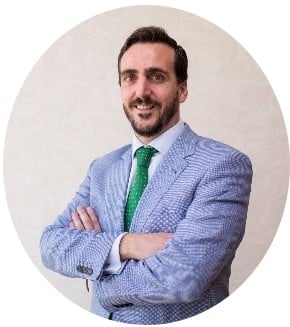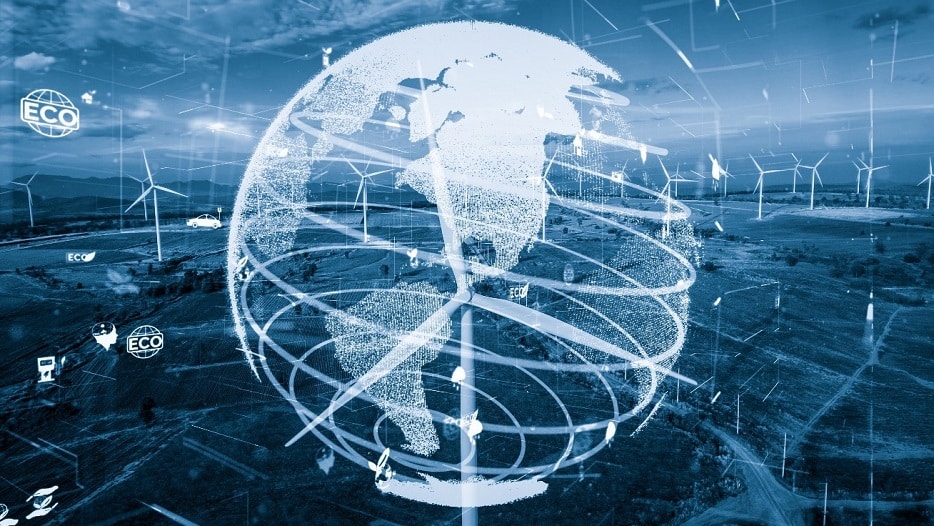Julia Maria Gomez de Avila Segade | 22/11/2022
Exponential growth in renewable energies has brought with it a new challenge: how to manage the waste these energy sources generate. The wind energy sector has been taking steps in this field for some time. In fact, it is feasible to recycle about 85% of the weight of wind turbine components. The Spanish and European wind energy industries have committed to the ability to reuse, recycle, or recover 100% of dismantled blades by 2025, a big challenge. We discussed the situation and projects with Tomás Romagosa, Technical Director of the Spanish Wind Energy Association (AEE [Asociación Empresarial Eólica]).
In recent years, the Spanish wind energy sector has maintained an upward trajectory in terms of the installation of new power and participation in the generation mix. In fact, if in 2020 wind energy represented the technology with the highest total power installed, in 2021 it became the main source within the Spanish energy mix. In the coming years, and as established in the Spanish National Energy and Climate Plan (PNIEC [Plan Nacional de Energía y Clima]), wind energy will continue to progress, with the goal of reaching 50 GW in 2030, compared to the 28 GW installed at the beginning of 2022.
At the same time, the first generation of wind turbines is nearing the end of their operational life. As Tomás Romagosa, Technical Director of AEE, reveals, “over the next few years, many wind farms will have to choose between extending the life of their assets or revamping to replace old wind turbines with newer ones.”
Feasibility of recycling
Currently, in Spain there are 1,298 wind farms in over 800 municipalities, with 21,574 wind turbines (AEE, 2021), of which around 36% were installed prior to 2005, meaning that they are over 15 years old.
Considering that the design life of a wind farm and its components is 20 years, many of these structures can be uninstalled in the coming years, although only the oldest ones will be scrapped at the end of this period, as the natural trend is the extension of the lifetime of wind farms.
This is because “in most cases, it is observed that wind turbines, when they reach their useful life, are still in good condition. Therefore, it is common to extend the operation of wind farms up to 25 or 30 years while maintaining operational and safety conditions,” states the AEE representative.
According to data from this association, today it is feasible to recycle or reuse 85% to 90% of a wind turbine’s weight. “Most major components (cement, tower, nacelle) have processes for their recycling or reuse, due to being made from materials such as steel, copper, aluminum, or concrete. Furthermore, it is common practice in the sector to use many of the components as spare parts,” adds Romagosa.
One priority: the blades
This is not the case with wind turbine blades, which pose a greater challenge for recycling because they are made of composite materials that are difficult to separate and therefore difficult to recycle, although, according to the expert, the impact of waste from these elements does not pose any risk.
By way of example, Romagosa cites that “the weight of all the blades that are expected to be dismantled annually represents only 1.4% of the total weight of plastic packaging that is not recycled in Spain at the end of the year. Furthermore, they are non-toxic, they do not produce leachates that can be harmful to the environment.”
However, he also acknowledges that “wind turbine blades are very bulky waste whose management is not yet fully resolved at a commercial level. Therefore, the implementation of circular economy measures is a priority for the wind energy sector, with the objective of reducing its ecological footprint and boosting its sustainability.”
Management within the sector
So far, the natural trend in the Spanish market has been to extend lifetime beyond the twenty years initially foreseen, the alternative with the lowest risk for the developer. Moreover, given the high investments required for repowering (the equivalent of virtually 100% of the investment required for a new wind farm), this option has become merely testimonial.
As of December 31, 2021, only 11 wind farms had been repowered in Spain and the wind turbines dismantled were mainly destined for the second-hand market. In fact, the Technical Director of AEE reveals: “Some Spanish companies are pioneers in generating second-hand markets on a global scale, through specific auctions, which allow wind farm owners to sell decommissioned wind assets, either for reinstallation in other locations or for use as spare parts.”
In other words, in Spain, the blades from wind farms that have been repowered to date have not had to be taken to landfill, but have been absorbed by these second-hand markets.
Main challenges
However, this seems likely to happen in the future for two main reasons: “The trend of extending the useful life beyond 20 years of operation cannot be prolonged indefinitely and the effect of the recently announced aid lines for the repowering of wind farms, linked to the Recovery, Transformation, and Resilience Plan,” Romagosa believes. “Over the next few years,” he adds, “the sector will have to manage an average of 20,000 tons of blades to be dismantled each year, for which reuse or recycling solutions must be sought.”
Another handicap is that “the technologies available for wind turbine blade recycling are not yet fully developed on a commercial scale” and the wind industry highlights the need for them to evolve in order to be more cost efficient and obtain better quality by-products, as they have a high margin for optimization.
In addition to this, there are still no industrial plants in Spain with sufficient capacity for the treatment of significant volumes of composite materials, beyond experimental pilot projects; and high investments are required to ensure sustainable waste management throughout the process.
For all these reasons, “the wind sector considers it essential to continue promoting R+D+i activities to improve the recycling technologies of composite materials, as well as promoting investments for the development of the market and of industrial capacities.”
Agents involved
Wind farm owners, wind turbine manufacturers, technology centers, and universities have been developing, for some time now, a multitude of projects focused on the eco-design of blades, the optimization of existing recycling technologies, and the implementation of new industrial capacities for the processing of this type of waste.
On the side of the Administration, they are also working to find solutions. Thus, the Recovery, Transformation, and Resilience Plan (PRTR [Plan de Recuperación, Transformación y Resiliencia]) includes measures to encourage the promotion of the circular economy at a national level. For example, at the end of 2021, the Strategic Projects for Economic Recovery and Transformation (PERTE [Proyectos Estratégicos para la Recuperación y Transformación Económica]) on Renewable Energies, Renewable Hydrogen, and Storage (ERHA [Energías Renovables, Hidrógeno Renovable y Almacenamiento]), was approved, whose third measure aims to repower wind farms conditional on the use of wind turbine blade recycling technologies or systems.
In early 2022, the Circular Economy PERTE was also published, which includes, within the wind sector objectives to drive eco-design measures, extending the life of the blades and improving their recyclability, as well as finding alternatives for discarded equipment from wind farms, which may have a second life in other uses (such as urban furniture, acoustic barriers on roads or railways, water reserves, telecommunication or electricity transmission towers, wave attenuators in coastal areas, roofs of warehouses and houses, etc.).
Circular economy projects
In June 2021, the Spanish and European wind energy industries committed to making it possible to reuse, recycle, or recover 100% of dismantled blades by 2025, thus avoiding their removal to landfill.
The growing interest of the wind energy sector in the circular economy is reflected in the number of wind turbine blade recycling plant projects that will be implemented in the near future. The objective of these initiatives will be to recover the materials from the wind turbine blades and reuse them in various sectors and industries.
Public announcements include:
- The consortium formed by Endesa, LM Wind Power, and PreZero. The project will involve an investment of approximately €8.5 million in a new plant in Cubillos del Sil (León), which will be operational in 2024 and is expected to be able to process 6,000 tons/year.
- Iberdrola, together with FCC Ámbito, will also install a blade recycling plant in Navarre with an investment of €10 million. The initiative will also be supported by Siemens Gamesa.
- Naturgy and Ruralia will start up a pilot plant for the comprehensive recycling of wind farms in Almazán (Soria).
An opportunity
In short, for Romagosa, “the achievement of circularity in the wind energy sector requires progress in the integration of different actors that cover the entire value chain, from waste generation to the end product, generating a national industry network that enables industrial and commercial scalability.”
To this end, in his opinion, “it is essential to maintain a close public-private collaboration and have the support of the Administration to promote innovation projects and develop industrial capacities.”
As one of the pioneering countries in wind farm installation, Spain is also one of the first countries to face the challenge of their decommissioning. “This situation is a great opportunity for our industry to take the lead in this activity and subsequently be able to export the technology and knowledge acquired to the rest of Europe and the world, as is already happening with the export of wind turbines,” the Technical Director of AEE points out.
Contributors to this article…
 Tomás Romagosa Cabezudo, Technical Director of the Spanish Wind Energy Association (AEE)
Tomás Romagosa Cabezudo, Technical Director of the Spanish Wind Energy Association (AEE)
Industrial Engineer and Organization Engineer at the Universidad Pontificia de Comillas [Comillas Pontifical University], Tomás Romagosa Cabezudo has been Technical Director of the Spanish Wind Energy Association (AEE) since 2017 and is responsible, among other things, for the activities of Offshore Wind, Integration of Wind into the Grid, Monitoring of the Electricity Market, Industrial Agenda, Operation and Maintenance, Extending the Lifetime of Wind Farms, Cybersecurity, and Preventing Occupational Risks.
He is also the secretary of the UNE CTN221 Technical Committee on Standardization of “Wind Power Generation Systems” and is a coordinator of the Wind Sector technology platform (REOLTEC), responsible for managing all issues related to innovation and R+D with the Administration. He has previously been a group coordinator within the Energy and Infrastructure Management of the public company ISDEFE.
Keep reading…“Offshore wind power is defining itself as a key player in the energy transition”





